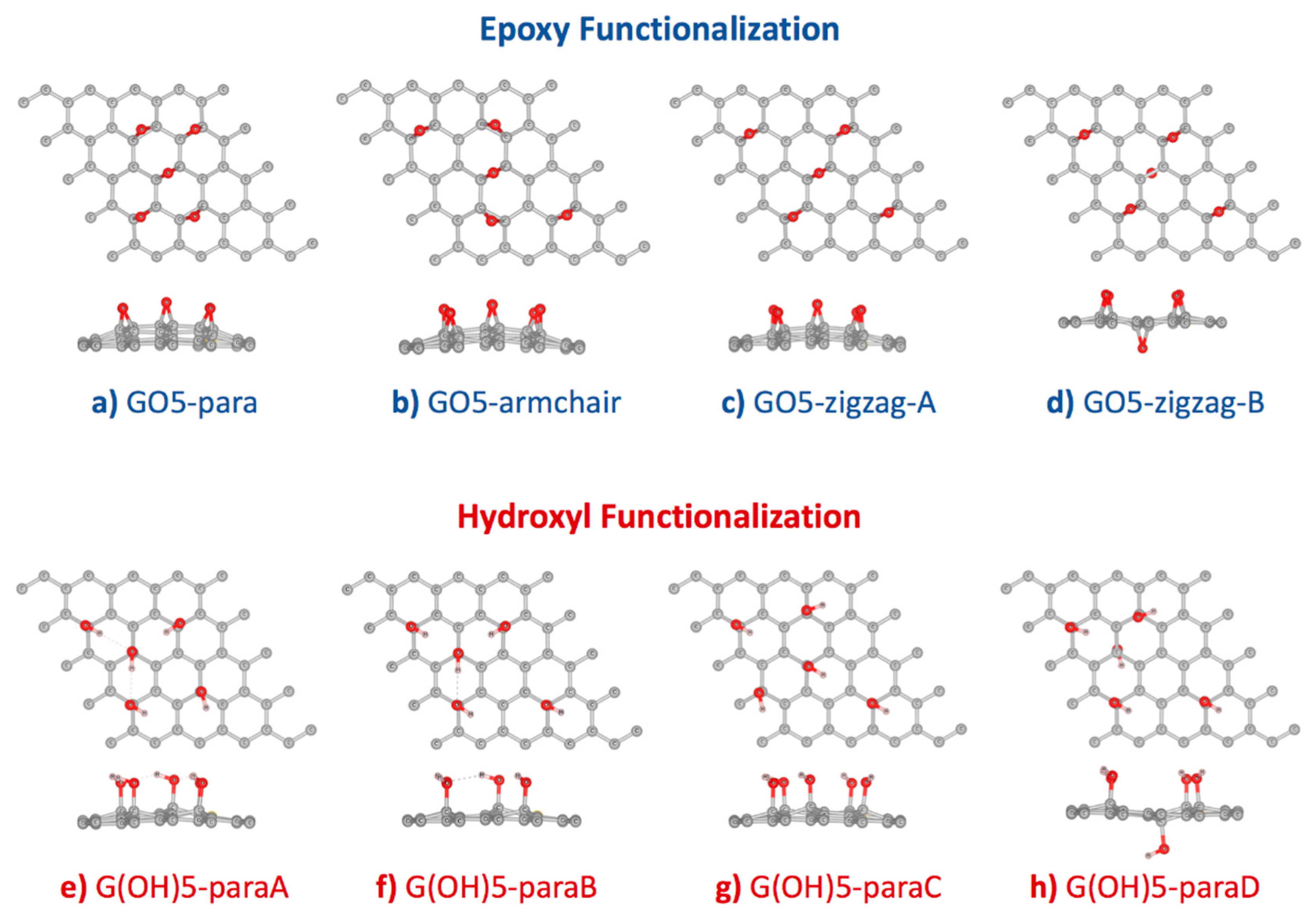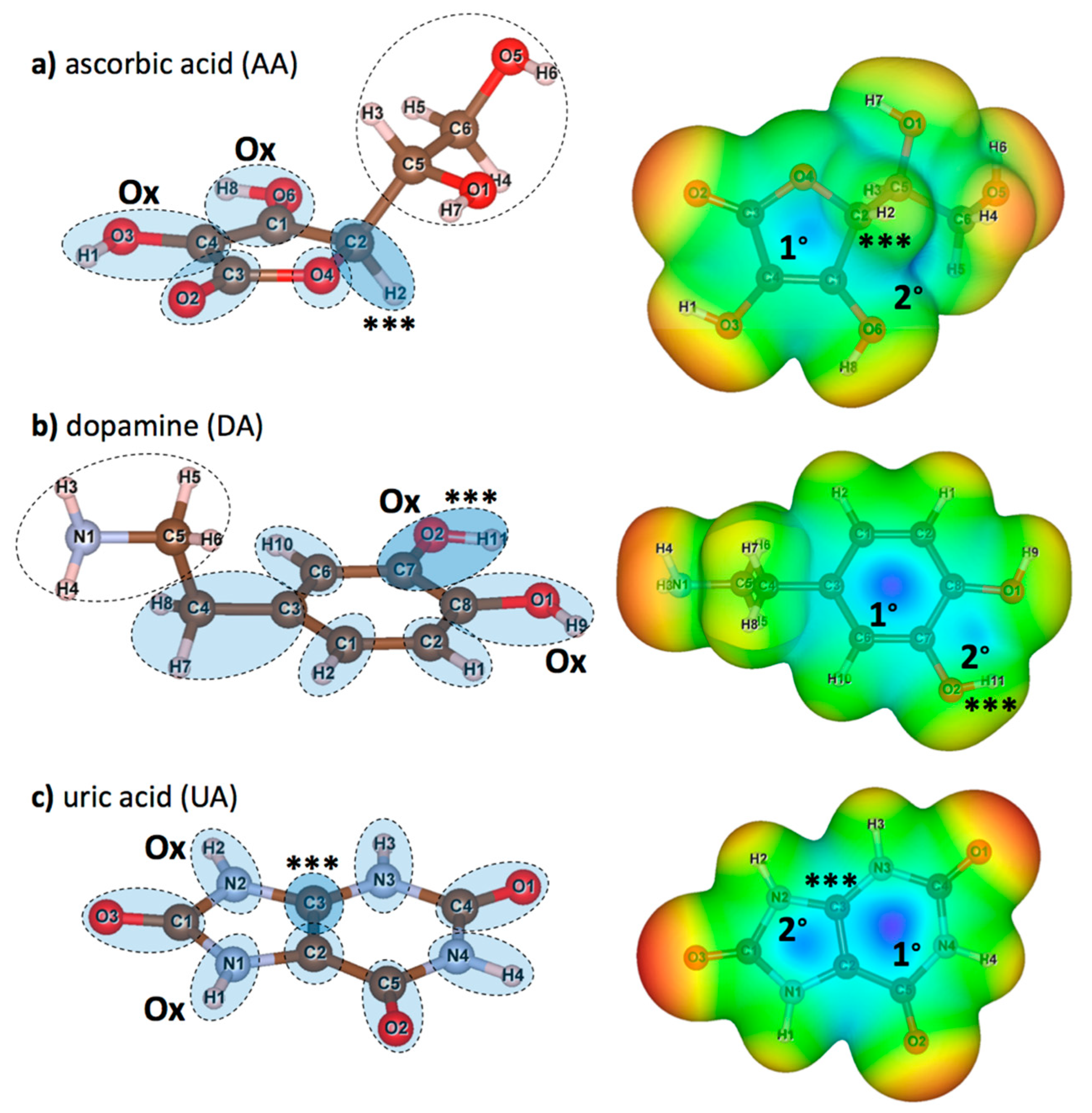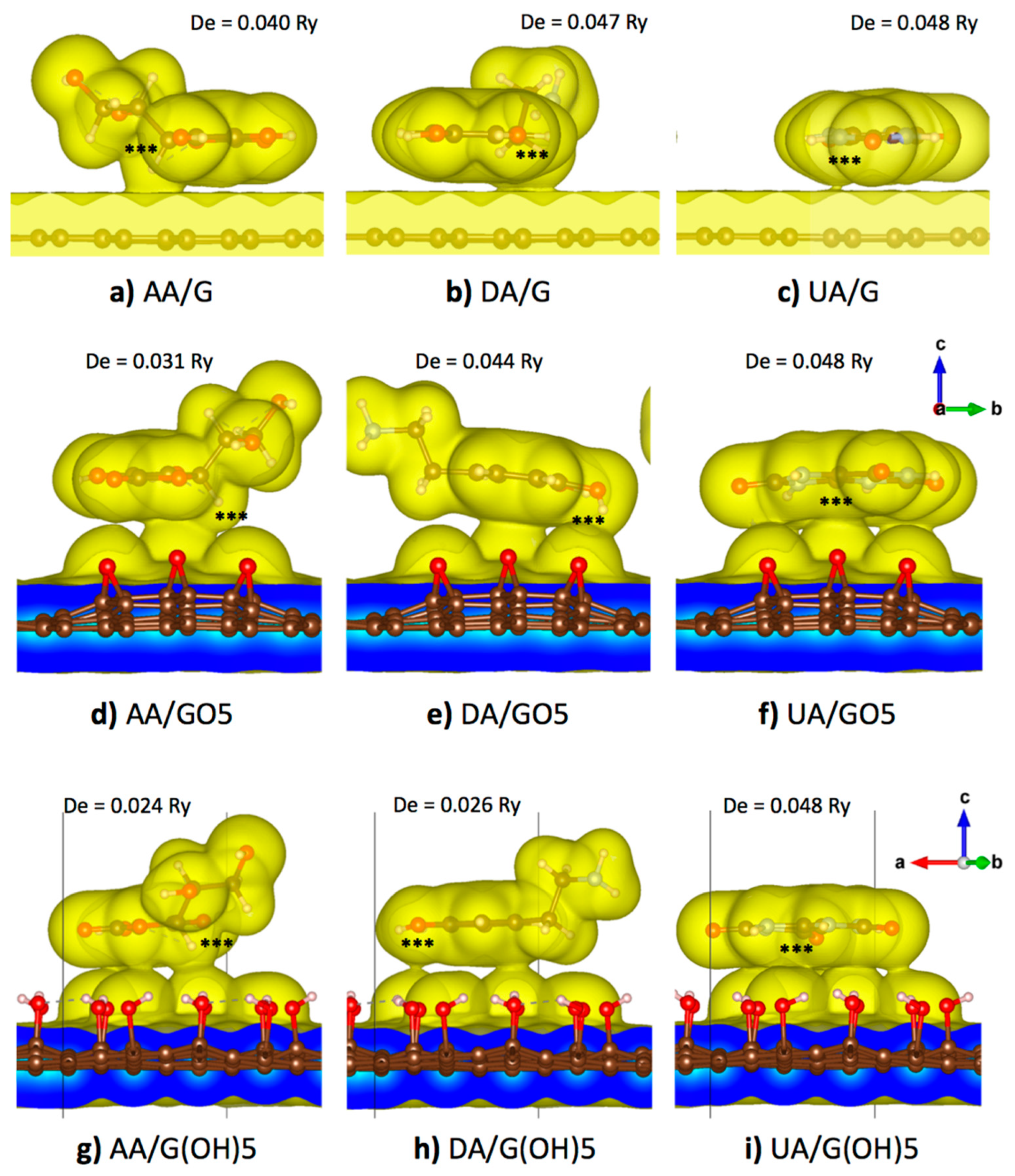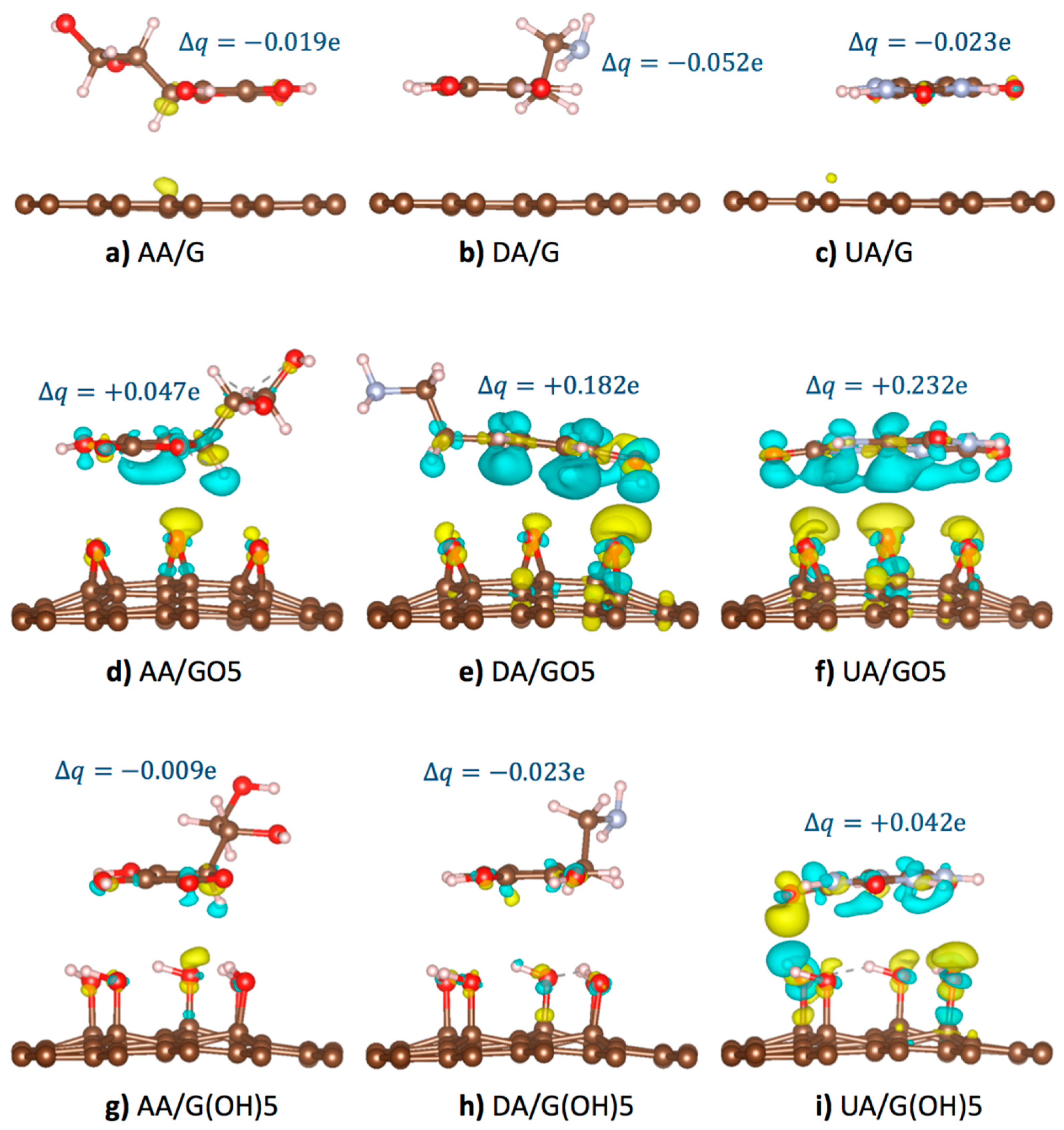Unveiling the Fundamental Mechanisms of Graphene Oxide Selectivity on the Ascorbic Acid, Dopamine, and Uric Acid by Density Functional Theory Calculations and Charge Population Analysis
Abstract
1. Introduction
2. Computational Methods
3. Results
3.1. Graphene Oxide Configuration
3.2. Charge Distribution and the Potential Surface of AA/UA/DA
3.3. Binding Configurations and Binding Strengths of AA/UA/DA on Graphene and GOs
3.4. AA, DA, and UA Charge Transfer Analysis
4. Discussion
5. Conclusions
Author Contributions
Funding
Acknowledgments
Conflicts of Interest
References
- Noroozifar, M. Solid-Phase Iodine as an Oxidant in Flow Injection Analysis: Determination of Ascorbic Acid in Pharmaceuticals and Foods by Background Correction. Talanta 2003, 61, 173–179. [Google Scholar] [CrossRef]
- National Collaborating Centre for Chronic Conditions (UK). Parkinson’s Disease: National Clinical Guideline for Diagnosis and Management in Primary and Secondary Care; National Institute for Health and Clinical Excellence, Guidance, Royal College of Physicians: London, UK, 2006; ISBN 978-1-86016-283-1. [Google Scholar]
- Heinig, M.; Johnson, R.J. Role of uric acid in hypertension, renal disease, and metabolic syndrome. Clevel. Clin. J. Med. 2006, 73, 1059–1064. [Google Scholar] [CrossRef]
- Khan, M.Z.H. Graphene Oxide Modified Electrodes for Dopamine Sensing. J. Nanomater. 2017, 2017, 1–11. [Google Scholar] [CrossRef]
- Jackowska, K.; Krysinski, P. New trends in the electrochemical sensing of dopamine. Anal. Bioanal. Chem. 2012, 405, 3753–3771. [Google Scholar] [CrossRef] [PubMed]
- Geim, A.K.; Novoselov, K.S. The rise of graphene. Nat. Mater. 2007, 6, 183–191. [Google Scholar] [CrossRef] [PubMed]
- Bard, A.J.; Faulkner, L.R. Electrochemical Methods: Fundamentals and Applications, 2rd ed.; Wiley: Hoboken, NJ, USA, 2001; ISBN 978-0-471-04372-0. [Google Scholar]
- Ou, L.; Song, B.; Liang, H.; Liu, J.; Feng, X.; Deng, B.; Sun, T.; Shao, L. Toxicity of Graphene-Family Nanoparticles: A General Review of the Origins and Mechanisms. Part. Fibre Toxicol. 2016, 13, 57. [Google Scholar] [CrossRef] [PubMed]
- Lundie, M.; Šljivančanin, Ž.; Tomić, S. Electronic and Optical Properties of Reduced Graphene Oxide. J. Mater. Chem. C 2015, 3, 7632–7641. [Google Scholar] [CrossRef]
- Shang, N.G.; Papakonstantinou, P.; McMullan, M.; Chu, M.; Stamboulis, A.; Potenza, A.; Dhesi, S.S.; Marchetto, H. Catalyst-Free Efficient Growth, Orientation and Biosensing Properties of Multilayer Graphene Nanoflake Films with Sharp Edge Planes. Adv. Funct. Mater. 2008, 18, 3506–3514. [Google Scholar] [CrossRef]
- Filik, H.; Avan, A.A.; Aydar, S. Simultaneous Detection of Ascorbic Acid, Dopamine, Uric Acid and Tryptophan with Azure A-Interlinked Multi-Walled Carbon Nanotube/Gold Nanoparticles Composite Modified Electrode. Arab. J. Chem. 2016, 9, 471–480. [Google Scholar] [CrossRef]
- Hung, P.-S.; Wang, G.-R.; Chung, W.-A.; Chiang, T.-T.; Wu, P.-W. Green Synthesis of Ni@PEDOT and Ni@PEDOT/Au (Core@Shell) Inverse Opals for Simultaneous Detection of Ascorbic Acid, Dopamine, and Uric Acid. Nanomaterial 2020, 10, 1722. [Google Scholar] [CrossRef]
- Wang, C.; Yuan, R.; Chai, Y.; Chen, S.; Zhang, Y.; Hu, F.; Zhang, M. Non-Covalent Iron(III)-Porphyrin Functionalized Multi-Walled Carbon Nanotubes for the Simultaneous Determination of Ascorbic Acid, Dopamine, Uric Acid and Nitrite. Electrochim. Acta 2012, 62, 109–115. [Google Scholar] [CrossRef]
- Liu, M.; Chen, Q.; Lai, C.; Zhang, Y.; Deng, J.; Li, H.; Yao, S. A Double Signal Amplification Platform for Ultrasensitive and Simultaneous Detection of Ascorbic Acid, Dopamine, Uric Acid and Acetaminophen Based on a Nanocomposite of Ferrocene Thiolate Stabilized Fe3O4@Au Nanoparticles with Graphene Sheet. Biosens. Bioelectron. 2013, 48, 75–81. [Google Scholar] [CrossRef] [PubMed]
- Wang, Q.; Sun, H.; Liu, Q.; Li, L.; Kong, J. Electrodeposition of Three-Dimensional Network Nanostructure PEDOT/PANI for Simultaneous Voltammetric Detection of Ascorbic Acid, Dopamine and Uric Acid. ChemistrySelect 2020, 5, 1288–1293. [Google Scholar] [CrossRef]
- Atta, N.F.; Galal, A.; El-Said, D.M. Novel Design of a Layered Electrochemical Dopamine Sensor in Real Samples Based on Gold Nanoparticles/β-Cyclodextrin/Nafion-Modified Gold Electrode. ACS Omega 2019, 4, 17947–17955. [Google Scholar] [CrossRef] [PubMed]
- Zhao, Z.; Zhang, M.; Chen, X.; Li, Y.; Wang, J. Electrochemical Co-Reduction Synthesis of AuPt Bimetallic Nanoparticles-Graphene Nanocomposites for Selective Detection of Dopamine in the Presence of Ascorbic Acid and Uric Acid. Sensors 2015, 15, 16614–16631. [Google Scholar] [CrossRef] [PubMed]
- Chen, Y.; Zhang, X.-F.; Wang, A.-J.; Zhang, Q.-L.; Huang, H.; Feng, J.-J. Ultrafine Fe3C Nanoparticles Embedded in N-Doped Graphitic Carbon Sheets for Simultaneous Determination of Ascorbic Acid, Dopamine, Uric Acid and Xanthine. Microchim. Acta 2019, 186, 660. [Google Scholar] [CrossRef]
- Noroozifar, M.; Khorasani-Motlagh, M.; Akbari, R.; Bemanadi Parizi, M. Simultaneous and Sensitive Determination of a Quaternary Mixture of AA, DA, UA and Trp Using a Modified GCE by Iron Ion-Doped Natrolite Zeolite-Multiwall Carbon Nanotube. Biosens. Bioelectron. 2011, 28, 56–63. [Google Scholar] [CrossRef] [PubMed]
- Demirkan, B.; Bozkurt, S.; Cellat, K.; Arıkan, K.; Yılmaz, M.; Şavk, A.; Çalımlı, M.H.; Nas, M.S.; Atalar, M.N.; Alma, M.H.; et al. Palladium Supported on Polypyrrole/Reduced Graphene Oxidenanoparticles for Simultaneous Biosensing Application of Ascorbic Acid, Dopamine, Anduric Acid. Sci. Rep. 2020, 10, 2946. [Google Scholar] [CrossRef] [PubMed]
- Wei, Y.; Liu, Y.; Xu, Z.; Wang, S.; Chen, B.; Zhang, D.; Fang, Y. Simultaneous Detection of Ascorbic Acid, Dopamine, and Uric Acid Using a Novel Electrochemical Sensor Based on Palladium Nanoparticles/Reduced Graphene Oxide Nanocomposite. Int. J. Anal. Chem. 2020, 2020, 1–13. [Google Scholar] [CrossRef] [PubMed]
- Bao, Y.; Song, J.; Mao, Y.; Han, D.; Yang, F.; Niu, L.; Ivaska, A. Graphene Oxide-Templated Polyaniline Microsheets toward Simultaneous Electrochemical Determination of AA/DA/UA. Electroanalysis 2011, 23, 878–884. [Google Scholar] [CrossRef]
- Wang, H.; Ren, F.; Wang, C.; Yang, B.; Bin, D.; Zhang, K.; Du, Y. Simultaneous Determination of Dopamine, Uric Acid and Ascorbic Acid Using a Glassy Carbon Electrode Modified with Reduced Graphene Oxide. RSC Adv. 2014, 4, 26895. [Google Scholar] [CrossRef]
- Zhou, M.; Zhai, Y.; Dong, S. Electrochemical Sensing and Biosensing Platform Based on Chemically Reduced Graphene Oxide. Anal. Chem. 2009, 81, 5603–5613. [Google Scholar] [CrossRef] [PubMed]
- Li, Q.; Xia, Y.; Wan, X.; Yang, S.; Cai, Z.; Ye, Y.; Li, G. Morphology-dependent MnO2/nitrogen-doped graphene nanocomposites for simultaneous detection of trace dopamine and uric acid. Mater. Sci. Eng. C 2020, 109, 110615. [Google Scholar] [CrossRef] [PubMed]
- Zhang, L.; Liu, C.; Wang, Q.; Wang, X.; Wang, S. Electrochemical Sensor Based on an Electrode Modified with Porous Graphitic Carbon Nitride Nanosheets (C3N4) Embedded in Graphene Oxide for Simultaneous Determination of Ascorbic Acid, Dopamine and Uric Acid. Microchim. Acta 2020, 187, 149. [Google Scholar] [CrossRef]
- Tan, C.; Zhao, J.; Sun, P.; Zheng, W.; Cui, G. Gold Nanoparticle Decorated Polypyrrole/Graphene Oxide Nanosheets as a Modified Electrode for Simultaneous Determination of Ascorbic Acid, Dopamine and Uric Acid. New J. Chem. 2020, 44, 4916–4926. [Google Scholar] [CrossRef]
- Kunpatee, K.; Traipop, S.; Chailapakul, O.; Chuanuwatanakul, S. Simultaneous Determination of Ascorbic Acid, Dopamine, and Uric Acid Using Graphene Quantum Dots/Ionic Liquid Modified Screen-Printed Carbon Electrode. Sens. Actuators B Chem. 2020, 314, 128059. [Google Scholar] [CrossRef]
- Giannozzi, P.; Baroni, S.; Bonini, N.; Calandra, M.; Car, R.; Cavazzoni, C.; Ceresoli, D.; Chiarotti, G.L.; Cococcioni, M.; Dabo, I.; et al. QUANTUM ESPRESSO: A Modular and Open-Source Software Project for Quantum Simulations of Materials. J. Phys. Condens. Matter 2009, 21, 395502. [Google Scholar] [CrossRef]
- Ernzerhof, M.; Scuseria, G.E. Assessment of the Perdew–Burke–Ernzerhof Exchange-Correlation Functional. J. Chem. Phys. 1999, 110, 5029–5036. [Google Scholar] [CrossRef]
- Paier, J.; Hirschl, R.; Marsman, M.; Kresse, G. The Perdew–Burke–Ernzerhof Exchange-Correlation Functional Applied to the G2-1 Test Set Using a Plane-Wave Basis Set. J. Chem. Phys. 2005, 122, 234102. [Google Scholar] [CrossRef]
- Thonhauser, T.; Cooper, V.R.; Li, S.; Puzder, A.; Hyldgaard, P.; Langreth, D.C. Van Der Waals Density Functional: Self-Consistent Potential and the Nature of the van Der Waals Bond. Phys. Rev. B 2007, 76, 125112. [Google Scholar] [CrossRef]
- Thonhauser, T.; Zuluaga, S.; Arter, C.A.; Berland, K.; Schröder, E.; Hyldgaard, P. Spin Signature of Nonlocal Correlation Binding in Metal-Organic Frameworks. Phys. Rev. Lett. 2015, 115, 136402. [Google Scholar] [CrossRef] [PubMed]
- Monkhorst, H.J.; Pack, J.D. Special Points for Brillouin-Zone Integrations. Phys. Rev. B 1976, 13, 5188–5192. [Google Scholar] [CrossRef]
- Momma, K.; Izumi, F. VESTA 3 for Three-Dimensional Visualization of Crystal, Volumetric and Morphology Data. J. Appl. Crystallogr. 2011, 44, 1272–1276. [Google Scholar] [CrossRef]
- Löwdin, P. Approximate Formulas for Many-Center Integrals in the Theory of Molecules and Crystals. J. Chem. Phys. 1953, 21, 374–375. [Google Scholar] [CrossRef]
- Yan, J.-A.; Chou, M.Y. Oxidation Functional Groups on Graphene: Structural and Electronic Properties. Phys. Rev. B 2010, 82, 125403. [Google Scholar] [CrossRef]
- Nakajima, T.; Mabuchi, A.; Hagiwara, R. A New Structure Model of Graphite Oxide. Carbon 1988, 26, 357–361. [Google Scholar] [CrossRef]
- Lerf, A.; He, H.; Forster, M.; Klinowski, J. Structure of Graphite Oxide Revisited. J. Phys. Chem. B 1998, 102, 4477–4482. [Google Scholar] [CrossRef]
- He, H.; Klinowski, J.; Forster, M.; Lerf, A. A New Structural Model for Graphite Oxide. Chem. Phys. Lett. 1998, 287, 53–56. [Google Scholar] [CrossRef]
- Guilhon, I.; Bechstedt, F.; Botti, S.; Marques, M.; Teles, L.K. Thermodynamic, Electronic, and Optical Properties of Graphene Oxide: A Statistical Ab Initio Approach. Phys. Rev. B 2017, 95, 245427. [Google Scholar] [CrossRef]
- Domancich, N.; Rossi Fernández, A.; Meier, L.; Fuente, S.; Castellani, N. DFT Study of Graphene Oxide Reduction by a Dopamine Species. Mol. Phys. 2020, 118, e1637029. [Google Scholar] [CrossRef]
- Araújo, M.P.; Soares, O.S.G.P.; Fernandes, A.J.S.; Pereira, M.F.R.; Freire, C. Tuning the Surface Chemistry of Graphene Flakes: New Strategies for Selective Oxidation. RSC Adv. 2017, 7, 14290–14301. [Google Scholar] [CrossRef]
- Dreyer, D.R.; Park, S.; Bielawski, C.W.; Ruoff, R.S. The Chemistry of Graphene Oxide. Chem. Soc. Rev. 2010, 39, 228–240. [Google Scholar] [CrossRef]
- Marcano, D.C.; Kosynkin, D.V.; Berlin, J.M.; Sinitskii, A.; Sun, Z.; Slesarev, A.; Alemany, L.B.; Lu, W.; Tour, J.M. Improved Synthesis of Graphene Oxide. ACS Nano 2010, 4, 4806–4814. [Google Scholar] [CrossRef] [PubMed]
- Stankovich, S.; Dikin, D.A.; Piner, R.D.; Kohlhaas, K.A.; Kleinhammes, A.; Jia, Y.; Wu, Y.; Nguyen, S.T.; Ruoff, R.S. Synthesis of Graphene-Based Nanosheets via Chemical Reduction of Exfoliated Graphite Oxide. Carbon 2007, 45, 1558–1565. [Google Scholar] [CrossRef]
- Fernández, A.C.R.; Castellani, N.J. Noncovalent Interactions between Dopamine and Regular and Defective Graphene. ChemPhysChem 2017, 18, 2065–2080. [Google Scholar] [CrossRef] [PubMed]
- Zhou, Q.; Liu, L.; Liu, Q.; Wang, Z.; Gao, C.; Liu, Y.; Ye, H. Highly Selective Adsorption on SiSe Monolayer and Effect of Strain Engineering: A DFT Study. Sensors 2020, 20, 977. [Google Scholar] [CrossRef] [PubMed]




| System | Epoxy Functionalization | Hydroxyl Functionalization | ||
|---|---|---|---|---|
| Eform/normal (eV) | ∆z (Å) | Eform/normal (eV) | ∆z (Å) | |
| GO5-para | −3.195 | 1.126 | −1.440 | 0.897 |
| GO5-armchair | −3.092 | 1.046 | −1.348 | 0.751 |
| GO5-zigzag-A | −3.140 | 0.998 | −1.191 | 0.894 |
| GO5-zigzag-B | −3.231 | 0.555 | −1.259 | 0.621 |
| AA | DA | UA | ||||||
|---|---|---|---|---|---|---|---|---|
| furanose | aromatic | aromatic | ||||||
| C1 | 0.186 | 0.106 | C1 | −0.176 | −0.034 | C1 | 0.513 | 0.032 |
| O6 | −0.476 | H2 | 0.142 | O3 | −0.481 | |||
| H8 | 0.397 | |||||||
| C2 | −0.200 | −0.055 | H1 | 0.324 | −0.025 | |||
| C4 | 0.085 | −0.029 | H1 | 0.145 | N1 | −0.349 | ||
| O3 | −0.508 | |||||||
| H1 | 0.395 | C8 | 0.184 | 0.029 | C2 | −0.018 | −0.018 | |
| H9 | 0.373 | |||||||
| C3 | 0.502 | 0.061 | O1 | −0.528 | C3 | 0.219 | 0.219 | |
| O2 | −0.440 | |||||||
| C7 | 0.227 | 0.098 | H2 | 0.312 | −0.055 | |||
| O4 | −0.341 | −0.341 | H11 | 0.378 | N2 | −0.367 | ||
| O2 | −0.507 | |||||||
| C2 | 0.040 | 0.211 | C5 | 0.412 | −0.069 | |||
| H2 | 0.171 | C6 | −0.189 | −0.033 | O2 | −0.481 | ||
| H10 | 0.156 | |||||||
| non−furanose | H4 | 0.317 | −0.076 | |||||
| C3 | 0.016 | 0.007 | N4 | −0.393 | ||||
| C5 | 0.053 | −0.009 | C4 | −0.281 | ||||
| C6 | −0.091 | H7 | 0.128 | C4 | 0.531 | 0.043 | ||
| O1 | −0.579 | H8 | 0.142 | O1 | −0.488 | |||
| O5 | −0.573 | |||||||
| H3 | 0.136 | non−aromatic | H3 | 0.314 | −0.047 | |||
| H4 | 0.131 | N3 | −0.361 | |||||
| H5 | 0.171 | C5 | −0.189 | −0.061 | ||||
| H6 | 0.366 | H3 | 0.267 | |||||
| H7 | 0.375 | H4 | 0.258 | |||||
| H5 | 0.142 | |||||||
| H6 | 0.110 | |||||||
| N1 | −0.650 |
| System | De (Ry) | α (1/Å) | re (Å) | ke (Ry/Å2) |
| AA/Graphene | 0.040 | 1.296 | 3.439 | 0.134 |
| DA/Graphene | 0.047 | 1.230 | 3.573 | 0.142 |
| UA/Graphene | 0.048 | 1.320 | 3.424 | 0.167 |
| AA/GO5 | 0.031 | 1.339 | 3.052 | 0.111 |
| DA/GO5 | 0.044 | 1.326 | 3.031 | 0.155 |
| UA/GO5 | 0.048 | 1.350 | 2.919 | 0.175 |
| AA/G(OH)5 | 0.024 | 1.427 | 2.720 | 0.098 |
| DA/G(OH)5 | 0.026 | 1.369 | 2.859 | 0.097 |
| UA/G(OH)5 | 0.048 | 1.379 | 2.553 | 0.183 |
| AA | ∆q(Ox) | ∆q(G) | ∆q(GO5) | ∆q(OH) |
|---|---|---|---|---|
| C1/O6/H8 * | −0.128 | −0.001 | 0.017 | −0.014 |
| C4/O3/H1 * | 0.011 | −0.003 | 0.021 | −0.005 |
| C3/O2 | 0.079 | 0.007 | 0.015 | 0.032 |
| O4 | 0.013 | −0.030 | −0.030 | −0.029 |
| C2/H2 | −0.037 | 0.008 | 0.025 | 0.007 |
| Total | −0.019 | 0.047 | −0.009 |
| DA | ∆q(Ox) | ∆q(G) | ∆q(GO5) | ∆q(OH) |
|---|---|---|---|---|
| C1/H2 | 0.036 | −0.004 | 0.029 | −0.009 |
| C2/H1 | 0.045 | 0.003 | 0.038 | −0.008 |
| C8/O1/H9 * | −0.200 | −0.002 | 0.062 | 0.009 |
| C7/O2/H11 * | −0.173 | −0.018 | 0.009 | 0.001 |
| C6/H10 | −0.009 | −0.008 | 0.007 | −0.005 |
| C3/C4/H7/H8 | 0.024 | −0.023 | 0.037 | −0.011 |
| Total | −0.052 | 0.182 | −0.023 |
| UA | ∆q(Ox) | ∆q(G) | ∆q(GO5) | ∆q(OH) |
|---|---|---|---|---|
| C1/O3 | 0.207 | −0.004 | 0.052 | 0.010 |
| H1/N1 * | −0.298 | −0.023 | 0.000 | −0.026 |
| C2 | 0.080 | 0.001 | 0.036 | −0.005 |
| C3 | 0.040 | 0.022 | 0.049 | 0.026 |
| H2/N2 * | −0.354 | −0.009 | −0.001 | −0.006 |
| C5/O2 | 0.205 | 0.005 | 0.052 | 0.014 |
| H4/N4 | 0.026 | −0.012 | 0.001 | −0.008 |
| C4/O1 | 0.072 | 0.005 | 0.034 | 0.032 |
| H3/N3 | 0.055 | −0.009 | 0.009 | 0.005 |
| Total | −0.023 | 0.232 | 0.042 |
Publisher’s Note: MDPI stays neutral with regard to jurisdictional claims in published maps and institutional affiliations. |
© 2021 by the authors. Licensee MDPI, Basel, Switzerland. This article is an open access article distributed under the terms and conditions of the Creative Commons Attribution (CC BY) license (https://creativecommons.org/licenses/by/4.0/).
Share and Cite
Prasert, K.; Sutthibutpong, T. Unveiling the Fundamental Mechanisms of Graphene Oxide Selectivity on the Ascorbic Acid, Dopamine, and Uric Acid by Density Functional Theory Calculations and Charge Population Analysis. Sensors 2021, 21, 2773. https://doi.org/10.3390/s21082773
Prasert K, Sutthibutpong T. Unveiling the Fundamental Mechanisms of Graphene Oxide Selectivity on the Ascorbic Acid, Dopamine, and Uric Acid by Density Functional Theory Calculations and Charge Population Analysis. Sensors. 2021; 21(8):2773. https://doi.org/10.3390/s21082773
Chicago/Turabian StylePrasert, Kittiya, and Thana Sutthibutpong. 2021. "Unveiling the Fundamental Mechanisms of Graphene Oxide Selectivity on the Ascorbic Acid, Dopamine, and Uric Acid by Density Functional Theory Calculations and Charge Population Analysis" Sensors 21, no. 8: 2773. https://doi.org/10.3390/s21082773
APA StylePrasert, K., & Sutthibutpong, T. (2021). Unveiling the Fundamental Mechanisms of Graphene Oxide Selectivity on the Ascorbic Acid, Dopamine, and Uric Acid by Density Functional Theory Calculations and Charge Population Analysis. Sensors, 21(8), 2773. https://doi.org/10.3390/s21082773





